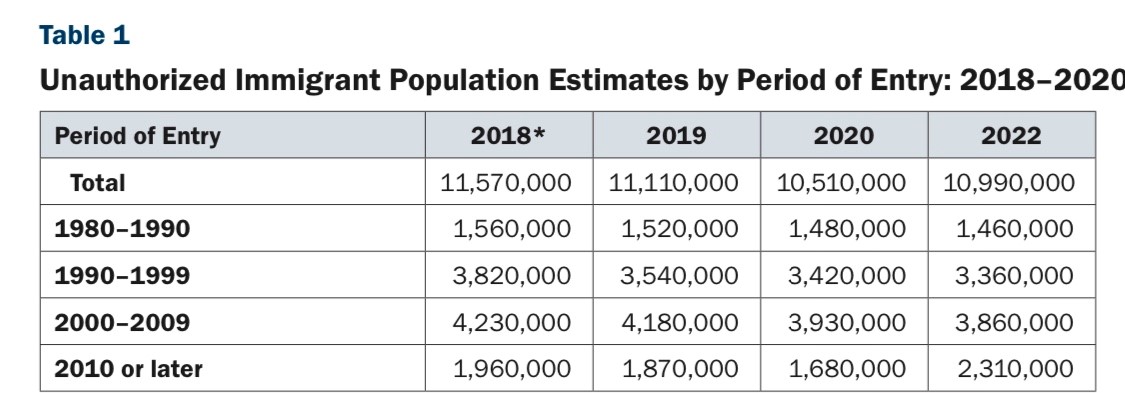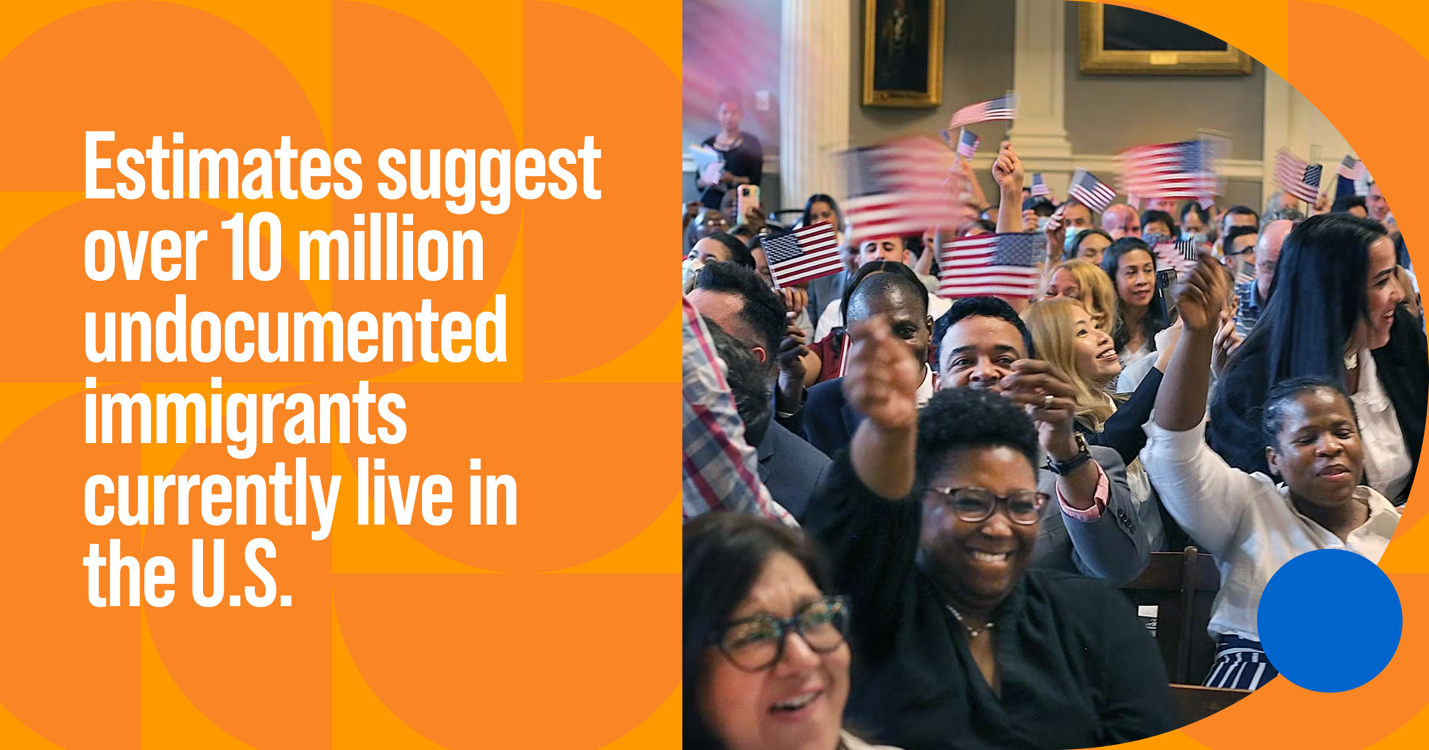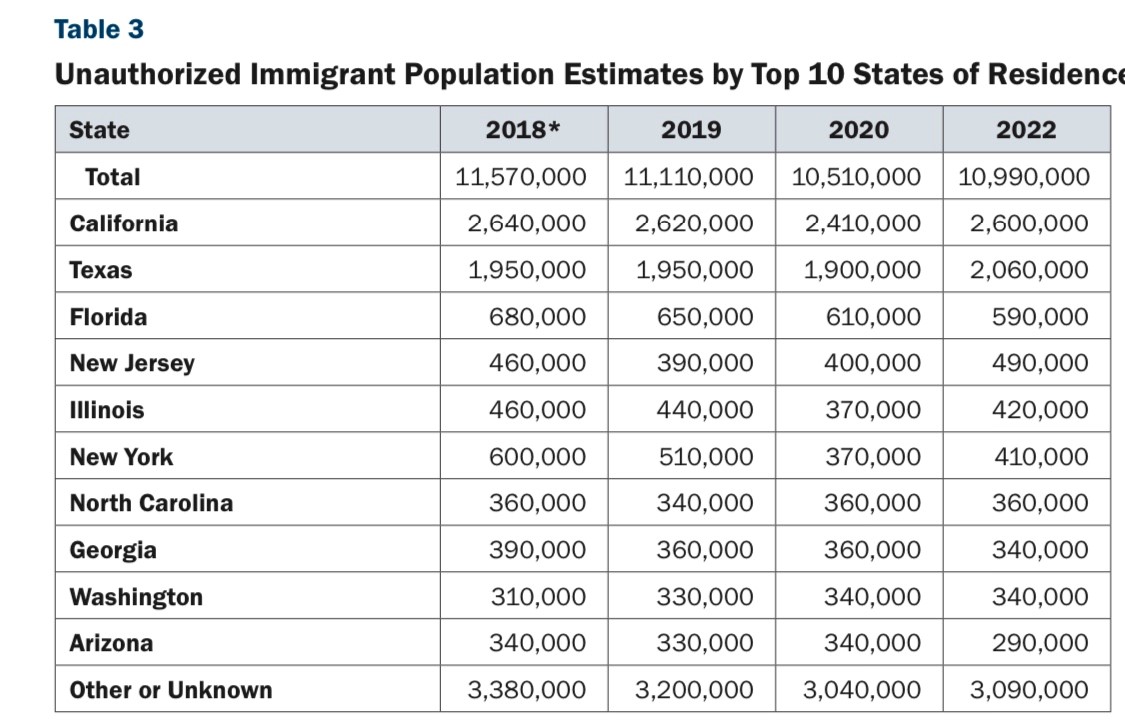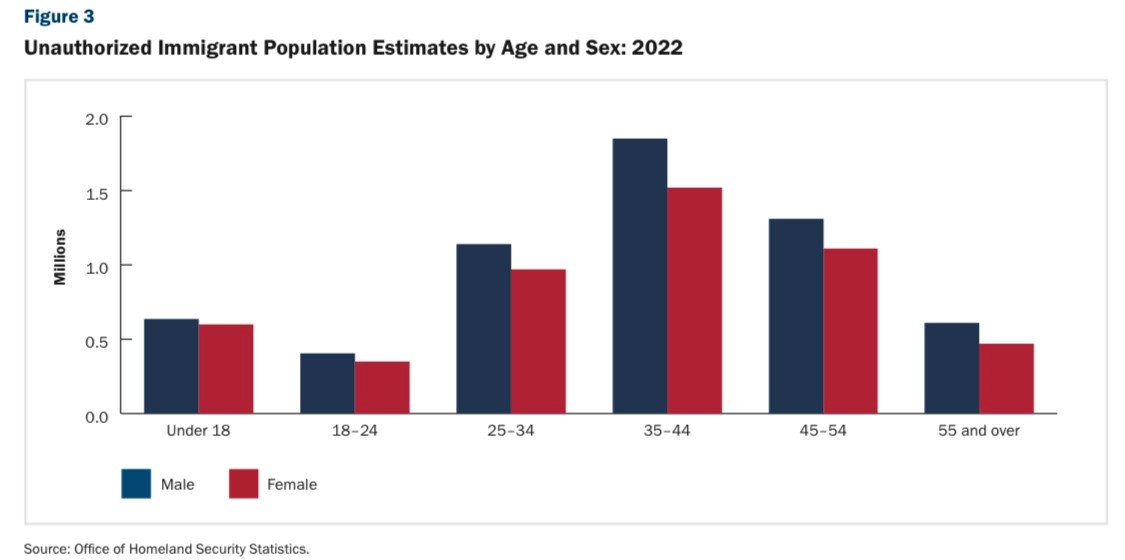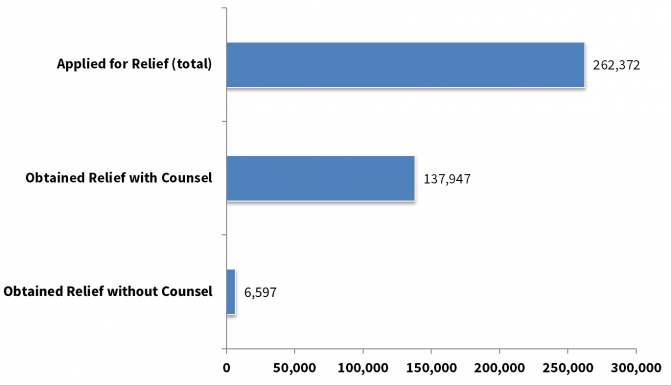The answer to the question of how many undocumented immigrants in USA remains uncertain due to the inherent difficulties in gathering accurate data. The nature of undocumented status means that many individuals are hesitant to disclose their circumstances, fearing deportation or other legal consequences. As a result, precise numbers are challenging to establish.
Instead of a specific count, estimates are calculated by examining the total foreign-born population in the U.S. and subtracting the number of immigrants the Department of Homeland Security (DHS) has documented as legally being in the country. Based on this method, the Office of Homeland Security Statistics estimates over 10 million unauthorized immigrants in the United States as of 2022.
Source: OHSS.DHS.gov
Origins and Demographics of Undocumented Immigrants
Most of the illegal immigrant population in the U.S. comes from Mexico and Central America. Historically, Mexico has been the largest source country, with many individuals migrating northward for better economic opportunities and safer living conditions. Central American countries, such as Guatemala, Honduras, and El Salvador, have also seen significant numbers of their citizens migrate due to economic hardship, violence, and political instability.
Despite widespread news suggesting that most undocumented immigrants enter the U.S. by crossing the border illegally, the reality is somewhat different. While border crossings do occur, a significant portion of the undocumented population consists of individuals who entered the country legally but overstayed their visas. These individuals arrived in the U.S. on tourist, student, or work visas but remained there after their legal permits expired.
Changing Trends in the Undocumented Population
Although there may not be an exact figure for how many undocumented immigrants in USA, their numbers have been declining in recent years. In 2018, the undocumented population was estimated at approximately 11.5 million. However, recent figures suggest a decrease. This decline is primarily attributed to a reduction in the number of Mexican nationals migrating to the U.S. Estimates from the Office of Immigration Statistics indicate that the number of undocumented immigrants from Mexico dropped by nearly 600,000 between 2018 and 2022. This decline reflects changing patterns of migration and enforcement.
Several factors may explain this trend. Mexico’s Economic conditions keep improving compared to previous decades, reducing the desire for migration. Additionally, increased border enforcement and the risks associated with crossing the U.S.-Mexico border may have deterred many potential migrants. Finally, stricter visa policies and improved tracking tools have made it more difficult for individuals to overstay their visas without detection.
Part of the report on how many undocumented immigrants in USA is that California and Texas are the leading states of residence. In 2022, these states had an estimated 2.6 million and 2.1 million undocumented immigrants, respectively. Together, they accounted for approximately 42% of the total unauthorized population in the country. This concentration is mainly due to the states’ economic opportunities, diverse immigrant communities, and proximity to the U.S.-Mexico border, which makes them primary destinations for many seeking better lives.
Source: OHSS.DHS.gov
In terms of demographics, a significant portion of the illegal immigrant population consists of males, with a notable percentage falling within the 35- to 44-year-old age range. This age group typically represents economically active individuals contributing to the agriculture, construction, and hospitality sectors. The prevalence of males in this demographic highlights the role of labor as a primary motivator for immigration, with many individuals coming to the U.S. seeking employment opportunities to support their families back home.
Source: OHSS.DHS.gov
Implications of Illegal Immigration
Illegal immigration has become a significant governmental issue, and the focus has often been on border security. Yet, many fail to recognize that most illegal immigrants are those who have not crossed the border but instead remained in the country after their visas expired. This reality shifts the discussion from border walls to reforming visa policies and addressing overstays.
The consequences of illegal immigration also extend beyond the individuals involved and impact the broader society. Illegal immigration can strain public resources, including education, healthcare, and social services. Communities may feel overwhelmed as classroom sizes increase, affordable housing becomes scarcer, and natural resources are stretched thin.
Additionally, the presence of undocumented immigrants poses challenges to national security. There is a concern that individuals seeking to harm the country could exploit the same vulnerabilities in the immigration system that allow others to remain undetected. Addressing these issues requires comprehensive immigration reform that balances humanitarian concerns with national interests.
Consequences of Being an Unauthorized Immigrant in the U.S.
Living as an undocumented immigrant in the United States comes with significant risks and challenges. Individuals face the constant threat of detention by Immigration and Customs Enforcement (ICE) or other law enforcement agencies. After detention, they may proceed to removal proceedings, where a deportation officer will decide whether to press charges. The charges may include accusations of unlawful entry, visa overstays, or other grounds.
After filing charges, the individual will be issued a Notice to Appear (NTA) in immigration court. At this point, they have the right to contest the charges and seek legal relief. However, the process can be lengthy and stressful, often resulting in detention by ICE. Although being detained by ICE does not automatically lead to deportation, it significantly increases the risk of removal if the individual has no legal right to remain in the country.
Legal Pathways for Undocumented Immigrants
Despite the challenges, legal pathways are available for immigrants living in the U.S. without authorization. These include applying for a Green Card through marriage to a U.S. citizen, serving in the military, or seeking asylum. The Biden administration has proposed legislation that could create an 8-year pathway to U.S. citizenship for undocumented immigrants. This proposal, known as the U.S. Citizenship Act, would allow undocumented individuals to apply for temporary legal status, eventually leading to permanent residency and citizenship eligibility.
Under this bill, Dreamers, Temporary Protected Status (TPS) holders, and immigrant farmworkers could be eligible for an expedited route to citizenship. The bill aims to provide more robust support for migrant families and promote the integration of refugees. If enacted, this legislation could transform the lives of millions of undocumented immigrants and significantly impact immigration in the United States.
How an Immigration Attorney Can Help Undocumented Immigrants
Undocumented immigrants have legal rights, even if they do not have legal status, and an experienced immigration attorney can help ensure those rights are protected and fully pursued.
Rights During Detention
When a law enforcement agency in the United States detains an undocumented immigrant, they are still entitled to certain legal protections. For example, if an immigration agency detains an individual suspected of being undocumented, they can only hold that person for up to 48 hours for ICE to take custody. If ICE fails to take over within this timeframe, the person must be released. An attorney can advocate on behalf of the detainee to ensure that these legal time limits are respected and that their rights are upheld during the detention period.
Rights During Removal Proceedings
If ICE does assume custody, the individual may be placed in removal proceedings. During this process, an immigration officer will decide whether to bring charges, such as unlawful entry or overstaying a visa. The detained immigrant will then receive a Notice to Appear (NTA), formally beginning the removal process and outlining the charges against them.
At this stage, an immigration attorney plays a crucial role. They can:
- Plead Your Case Before an Immigration Judge: Unlike criminal court judges, immigration judges are part of the Executive Office for Immigration Review (EOIR), separate from ICE. An attorney can present arguments, evidence, and testimonies to counter the charges, advocating for the immigrant’s right to remain in the country.
- Seek Relief from Removal: Three main types of relief may be available to undocumented immigrants facing removal. These include:
- (i) Asylum: If the individual fears persecution in their home country based on race, religion, nationality, political opinion, or membership in a particular social group, they may be eligible to seek asylum in the U.S.
- (ii) Cancellation of Removal: If the individual has been in the U.S. for a significant period, has strong family ties, and can demonstrate good moral character, they may be eligible for cancellation of removal, allowing them to stay in the country legally.
- (iii) Adjustment of Status: If the individual has a qualifying relationship, such as a U.S. citizen spouse or child, they may be able to adjust their status to that of a lawful permanent resident.
- Voluntary Departure: If an undocumented immigrant wants to leave the U.S. voluntarily rather than face formal deportation, an attorney can negotiate the terms of this departure. Voluntary departure allows the individual to leave the country on their own terms and avoid a deportation order on their record, which can have severe consequences for future immigration applications.
Source: Americanimmigrationcouncil.org
At every stage in immigration court proceedings, representation is associated with considerably more successful case outcomes.
If you or someone you know is an undocumented immigrant, trying to keep up with the U.S. immigration system can be challenging. It is crucial to seek the guidance of an experienced immigration attorney who can advise on your legal options and represent you in any proceedings. Immigration law is complex, and having professional support will help you understand it better.
Frequently Asked Questions About How Many Undocumented Immigrants in USA
1. How many undocumented immigrants are currently living in the U.S.?
The exact number of undocumented immigrants in the U.S. is difficult to determine due to the nature of the situation. However, estimates from DHS suggest that the number is over 10 million as of 2022.
2. What is the primary reason for undocumented immigration to the U.S.?
While many undocumented immigrants have entered the U.S. by crossing the border illegally, the majority overstayed their visas. These individuals initially entered the country legally but remained after their visas expired.
3. Which states have the highest number of undocumented immigrants?
California and Texas have the largest undocumented populations, with approximately 2.6 million and 2.1 million individuals, respectively. Together, they account for around 42% of the total undocumented population in the U.S.
4. What legal rights do undocumented immigrants have if ICE detains them?
Undocumented immigrants have legal rights even if they are not in the country legally. If detained by ICE, they have the right to due process, which includes the right to a hearing before an immigration judge to contest their deportation and to seek relief, such as asylum or cancellation of removal.
5. What should an undocumented immigrant do if law enforcement detains them?
Detained individuals must remain calm and assert their right to remain silent. They should seek legal representation as soon as possible. An immigration attorney can provide guidance and protect their rights during detention and removal.
6. Can undocumented immigrants apply for a green card or legal status?
There are several pathways to legal status for undocumented immigrants, including marriage to a U.S. citizen, service in the military, asylum, etc. The process can be complex, and an immigration attorney can provide valuable assistance.
7. How can an undocumented immigrant avoid deportation?
There are several defenses against deportation, such as applying for asylum, cancellation of removal, or adjustment of status. The options available depend on the individual’s circumstances, and an experienced immigration attorney can help identify the best course of action.
8. What is the difference between voluntary departure and deportation?
Voluntary departure allows an undocumented immigrant to leave the U.S. on their own terms without a formal deportation order on their record. Voluntary departure can be beneficial for future immigration prospects. Deportation, on the other hand, is a forced removal and can have long-term consequences for re-entry into the U.S.
9. What happens if an undocumented immigrant works in the US?
Undocumented immigrants often experience harsh treatment in the workplace due to their vulnerable status. They may endure low wages, unsafe working conditions, and long hours. Although U.S. labor laws prohibit employers from engaging in abusive or exploitative practices, undocumented immigrants fear reporting these violations. Doing so could expose their immigration status, leading to severe consequences.
10. What is the current U.S. policy on undocumented immigrants under the Biden administration?
The Biden administration has proposed the U.S. Citizenship Act, which includes a pathway to citizenship for undocumented immigrants. This proposal allows eligible individuals to apply for temporary legal status and, eventually, a green card and citizenship.
About Immigration Question
ImmigrationQuestion.com is a revolutionary platform that connects immigration attorneys to people who have immigration-related enquiries. We provide guidance on U.S. visas, citizenship, and green cards, keep you informed with the latest immigration news, and foster a knowledgeable community for support and insights.


